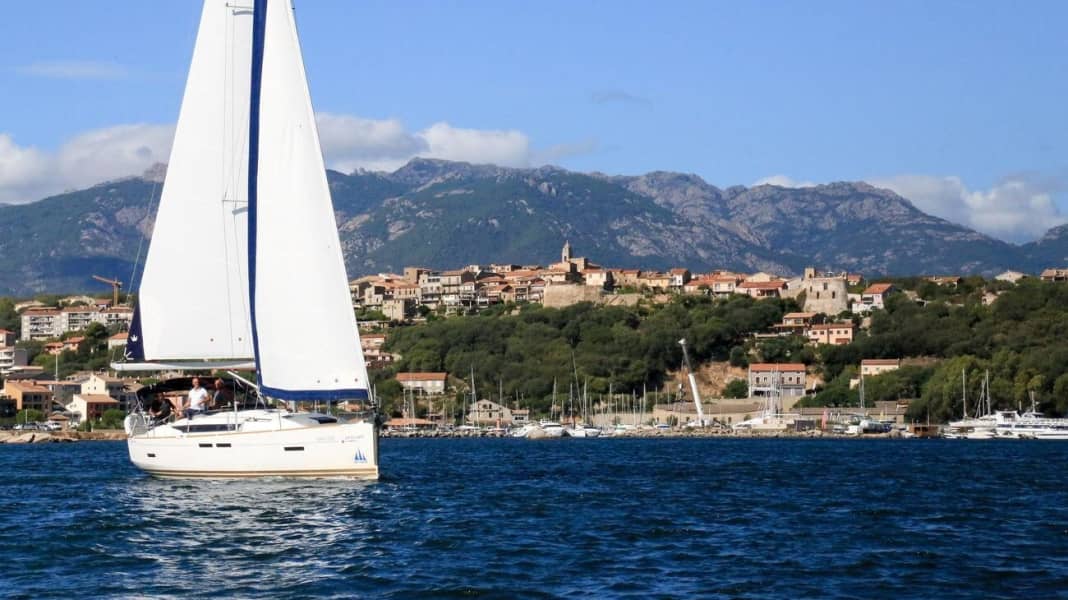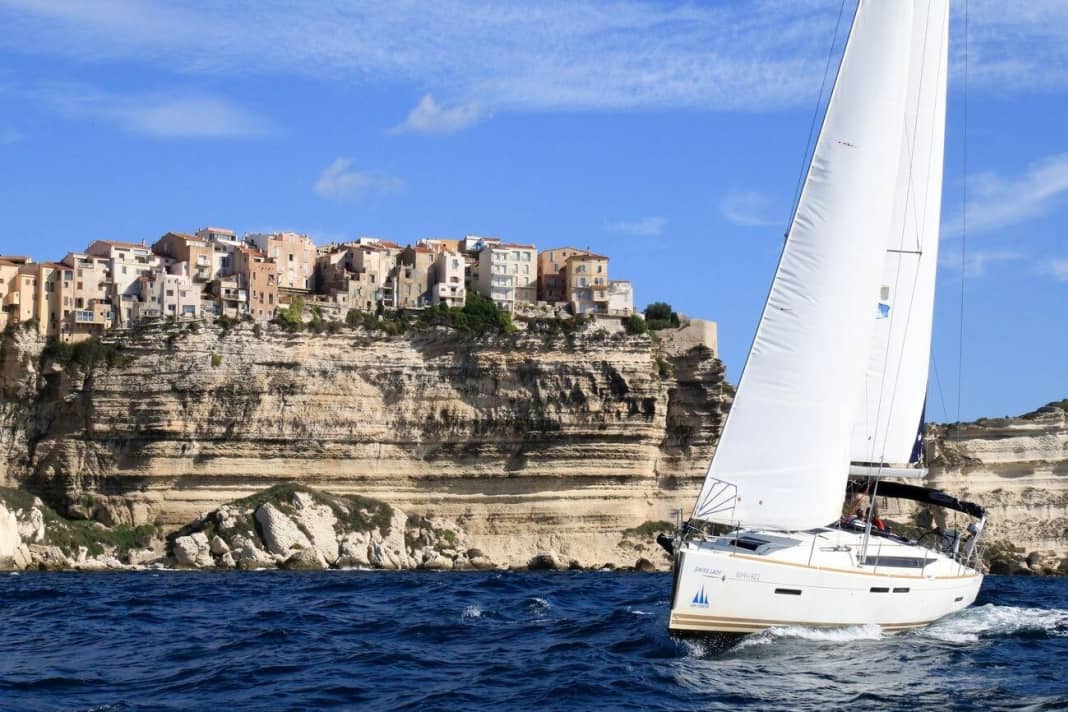

ARRIVAL
There are good flight connections to Olbia from Germany. Prices vary between 250 and 350 euros, depending on the departure airport. Those sailing in the south-west usually travel via Cagliari. Transfers are short in the north, around 20 to 30 minutes by taxi, in the south it is around 1.5 to two hours to Carloforte.
CHARTER






In the north, there are a large number of charter fleets in the immediate vicinity of Olbia, for example Portisco, Cannigione and others. The journey is pleasantly short, all are practically right in the heart of the area, it is only a few miles to the next beautiful bay or the next harbour.
If you want to go to the south-west, south or west coast of the islands, start from Cagliari or Carloforte further south.

WIND & WEATHER
In summer, winds often blow from the north-west along the north coast, often around 5 to 6 Beaufort in the Strait of Bonifacio due to the jet effect between Sardinia and Corsica. Around the Maddalena archipelago, on the other hand, it often blows from the south-east to south-west, around 4 Beaufort. In the low season, the mistral in the Strait of Bonifacio brings a lot of wind and also high swell from the north-west. The most reliable mistral forecasts from the French weather service, here the website with the forecasts.
In autumn, strong winds can also blow from the south-east.
NAVIGATION & SEAFARING
Sardinia and the Lavezzis as well as the south side of Corsica are peppered with shallows and rocks, which are part of the appeal of the area, but also mean a certain degree of difficulty. Skippers should always keep an eye on their plotter and chart. There are also many individual rocks just below the surface of the water, and charter crews frequently run aground.
In Italy, minimum distances from coasts and harbour entrances apply when anchoring, otherwise severe fines can be imposed. The Italian coastguard regularly carries out sporadic checks. The minimum distances are 300 metres from harbour entrances, 200 metres from beaches and 100 metres from rocky coasts.
There is a large national park around the island of La Maddalena, which includes many of the neighbouring islands. Travelling there costs a fee, and there are a whole series of anchoring bans and restricted areas to be observed. For example, anchoring is not permitted at night in some zones, not even in mooring buoy fields and certainly not in sea grass areas. In addition, the yacht must be equipped with a holding tank for overnight stays. There is a multilingual flyer on the park administration website (http://www.lamaddalenapark.it/download/documenti/zonizzazione/zonizzazione-2011-web.pdf) that summarises all the rules.
General information on navigating the La Maddalena National Park area can also be found at www.lamaddalenapark.net (under "Zonation Map"). The entrance fee for the national park area is 2 euros per day and metre of boat (for boats up to 16 metres). It can often be purchased in advance from the charter company.
HANDLES & ANCHORS
The area is famous for its many beautiful anchor bays with marvellous sandy beaches, fantastic rock formations and turquoise waters. These can be found particularly in the north-east of the island and on the small offshore islands of Maddalena and Lavezzi. They are often deeply indented and offer good protection in shallow water, ideal for safe anchoring. The islands often have sheltered bays for every wind direction, so you can easily anchor in changing weather conditions. If you want, you can easily spend a week or more here without getting bored. In the high season, however, the popular bays do get crowded. There are buoys in some of them, which are a good alternative. Anchoring is usually free-swimming, and because of the distances to be maintained from the shore and bathing areas, shore lines or similar are rather unusual.
The harbour network on the Sardinian coast is good, with marinas such as Portisco, Cannigione and Porto Cervo offering berths. However, they are expensive, and the latter in particular is almost unaffordable for charter crews in summer, as it is a mecca for mega yachts. In Italy, it makes sense to contact the harbour in advance via VHF radio, and reservations are also quite common. Marineros help with mooring lines and the service is usually good. This is complemented by some municipal harbours, such as the one in the main town of La Maddalena on the island of the same name. Otherwise, there are moorings on a few islands and the area is particularly suitable for those who enjoy beautiful anchorages. This also applies to the Lavezzi Islands, which belong to Corsica.
LITERATURE & NAUTICAL CHARTS
Klaus-Jürgen Röhring and Martin Muth, "Korsika, Sardinen, Elba", Delius Klasing Verlag, 29.90 euros. Rod Heikell, "Küstenhandbuch Italien", Edition Maritim, 69.90 euros. Italian pleasure craft chart set "North-East Sardinia", Kit IP P3a, 84 euros. NV-Verlag set IT 03/04, 49 euros.
TERRITORY CHARACTERISTICS
The area with its fantastic beaches, sometimes rounded rock formations, sometimes wildly rugged, is without question one of the most beautiful in the entire Mediterranean. The lovely landscape of the Costa Smeralda is famous and has magically attracted tourists and the super-rich with their mega yachts for decades. Crews usually start on the mainland and then go island hopping at its finest to the offshore islands of the Maddalena archipelago, whose beaches and cosy bays with crystal-clear, turquoise water (hence the name "Emerald Coast") invite you to swim. The area is a real anchoring paradise. It also offers an Italian lifestyle and a beautiful, surprisingly green, slightly mountainous landscape with spectacular rock formations. As large parts of the offshore islands are a nature reserve, the area has not been spoilt by too much development, despite being very busy in summer.
The distances to the next bay, the next harbour are short, even from Sardinia's north side to Corsica it is less than ten nautical miles. If you want to, it only takes two or three hours to sail to the next attractive bay.
However, the area is not considered easy for two reasons: firstly, the coast is lined with many shallows and rocks that require careful navigation. And secondly, the strait between Sardinia and Corsica is a notorious wind gust, especially when a strong mistral is blowing, which happens regularly even in midsummer and can last for several days. It is therefore not necessarily a destination for beginners, especially in spring and autumn.
Sailing off Sardinia is perfectly rounded off by the change of area to the French neighbour. Corsica and the Lavezzi Islands are just as much an anchorage paradise as the islands on the Italian side. Many crews like to use the trip for a detour to Bonifacio, the harbour spectacularly situated in a crevice, above which the fortified historic old town towers. It is almost like entering a fjord and, once you have climbed to the top, you have an incredible view. Even just a week's charter is enough for this detour, but there is no doubt that Sardinia offers enough destinations for a fortnight, and a large number of sailors regularly return.

